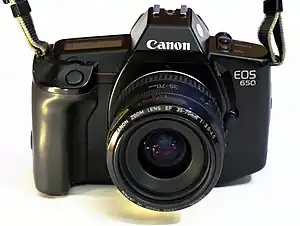 | |
| Overview | |
|---|---|
| Type | 35mm SLR |
| Lens | |
| Lens mount | Canon EF lens mount |
| Focusing | |
| Focus | TTL phase detection autofocus |
| Exposure/metering | |
| Exposure | Program, Aperture priority, Shutter priority and depth-of-field autoexposure; match-needle manual 6 zone evaluative or 6.5% partial metering |
| Flash | |
| Flash | Hot shoe only |
| Shutter | |
| Frame rate | 3 frame/s |
| General | |
| Dimensions | 148 × 108 × 68 mm, 660 g |
The Canon EOS 650 is a 35 mm single-lens reflex camera. It was introduced on 2 March 1987,[1] Canon's 50th anniversary,[2] and discontinued in February 1989.[3] It was the first camera in Canon's new EOS series, which was designed from scratch to support autofocus lenses. The EOS system features the new EF lens mount, which uses electrical signals to communicate between the camera and the lens.[4] Focusing and aperture control are performed by electric motors mounted in the lens body. The EF mount is still used on Canon SLRs, including digital models. Canon's previous FD mount lenses are incompatible with EOS bodies.
Canon's first EOS camera had the latest technologies, including a microprocessor and a Canon-developed BASIS sensor for high-precision AF. Canon claimed incomparable autofocusing for the EOS 650. A range of high-precision ultrasonic motor EF autofocus lenses were also developed successfully for the 650.
An EOS 650 was used in 1992 to take the first photographic image that was uploaded on the World Wide Web, a picture of the band Les Horribles Cernettes.[5]
The EOS 5D Mark III DSLR was announced on the 25th anniversary of the announcement of the EOS 650.[1]
Variants
The more advanced EOS 620 followed in May 1987,[6] and the EOS 630/600 in March 1989.[7] The 620 was equipped with LCD backlight, multiple exposure and auto-bracketing capability, and a higher flash sync speed of 1/250 and shutter speed of 1/4000. The 630/600 was the first EOS camera sold with different names in different markets (630 in Japan and USA, 600 in Europe) and the first available in multiple colours (the 630 in black or "metallic grey", the 600 only in "metallic grey"). All 630/600 models have faster autofocus with "focus prediction", 7 custom functions (including options for back-button focus and film leader out), 7 Programmed Image Control (PIC) modes and 5 frames per second film transport, an improvement from the 650's 3 fps. The Canon EOS RT is a pellicle mirror version of the EOS 630 with 8ms shutter lag and an additional eight custom functions (15 in total). Only 25,000 RT bodies were made.[8][9]
References
- 1 2 Westlake, Andy; Butler, Richard (March 2012). "Canon EOS 5D Mark III Hands-on Preview: 1. Introduction". Digital Photography Review. Archived from the original on 3 March 2012. Retrieved 2 March 2012.
- ↑ Canon Inc. "Canon Camera Story, 1987–1991". Canon Camera Museum. Archived from the original on 1 March 2008. Retrieved 3 October 2006.
- ↑ Foo, Leo; et al. (2002). "Canon EOS-650 – Technical Specifications". Photography in Malaysia. Retrieved 3 October 2006.
- ↑ Canon Inc. "EOS650". Canon Camera Museum. Archived from the original on 27 August 2006. Retrieved 3 October 2006.
- ↑ How the first photo was posted on the Web 20 years ago, Andrew Hough, The Telegraph, 11 July 2012
- ↑ "CANON EOS 620 QD (Quartz Date) film-based 135mm (36 x 24mm) format AF-SLR camera". Malaysian Internet Resources.
- ↑ "CANON EOS 630 QD (Quartz Date) film-based 135mm (36 x 24mm) format AF-SLR camera". Malaysian Internet Resources.
- ↑ Bob Atkins (2 May 2008). "Discontinued Canon EOS Film Bodies". Bob Atkins Photography.
- ↑ "Canon EOS 620 & EOS 650". Ken Rockwell Photography.
External links
![]() Media related to Canon EOS 650 at Wikimedia Commons
Media related to Canon EOS 650 at Wikimedia Commons